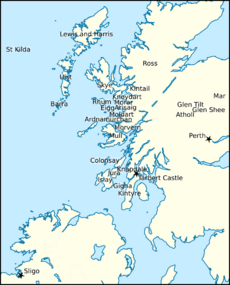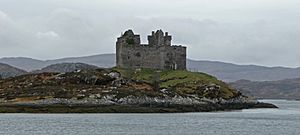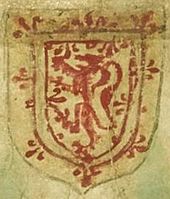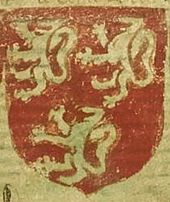Raghnall Mac Ruaidhrí facts for kids
Quick facts for kids
Raghnall Mac Ruaidhrí
|
|
|---|---|

Raghnall's name as it appears on folio 1v of National Library of Scotland Advocates' 72.1.1 (MS 1467): "Raghnall finn".
|
|
| Predecessor | Ruaidhrí Mac Ruaidhrí |
| Successor | Áine Nic Ruaidhrí |
| Died | October 1346 Elcho Priory |
| Noble family | Clann Ruaidhrí |
| Father | Ruaidhrí Mac Ruaidhrí |
Raghnall Mac Ruaidhrí (died October 1346) was a powerful Scottish leader and chief of Clann Ruaidhrí. His father, Ruaidhrí Mac Ruaidhrí, likely died in 1318. At that time, Raghnall might have been too young to rule.
After his father's death, Raghnall faced challenges from his aunt, Cairistíona. She was married to a member of the Mar family. Despite these challenges, Raghnall eventually took over his father's lands. He first appears in historical records in 1337.
Raghnall controlled large areas in the Hebrides and West Highlands. This led to conflicts with a nearby powerful lord, William III, Earl of Ross. These disagreements likely caused Raghnall's murder by the Earl's followers in 1346. After Raghnall's death, his family's lands went to his sister, Áine. Her husband, Eóin Mac Domhnaill I, Lord of the Isles, then gained control. This made him even more powerful in the Hebrides as Lord of the Isles.
The Clann Ruaidhrí Family
Raghnall was known as "Raghnall Fionn," which means "white" or "fair." He was the son of Ruaidhrí Mac Ruaidhrí. His family, Clann Ruaidhrí, was named after his grandfather. Raghnall's father ruled a large area that included mainland places like Moidart, Arisaig, Morar, and Knoydart. It also included islands such as Rhum, Eigg, Barra, St Kilda, and Uist. This territory was as big as some of the kingdom's earldoms.
After Raghnall's father died, there were disagreements over who should inherit the family lands. Raghnall's father was not born in a marriage, but he gained control after his half-sister, Cairistíona, gave up her rights to him.
Raghnall's father was likely the Clann Ruaidhrí leader who died in 1318 while fighting in Ireland. At that time, Raghnall was probably still young. It seems Cairistíona and her allies tried again to take control of the inheritance. Even though Cairistíona gave up her rights to another person, Raghnall managed to secure the region. Most of his family saw him as the true chief of Clann Ruaidhrí.
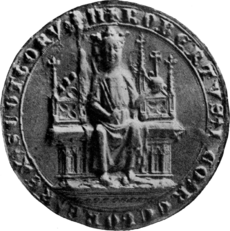
In 1325, King Robert I took away the lands of a person called "Roderici de Ylay." This might have been Raghnall himself. If so, it could have happened because Raghnall resisted Cairistíona's attempts to give the Clann Ruaidhrí lands to the Campbell family. It could also have been because Clann Ruaidhrí was expanding into areas that the king did not want them to control.

King Robert I might have personally enforced this decision. He visited Tarbert Castle, a strong royal fortress in Kintyre, in the same year. The king seemed to be helping families like the Campbells grow stronger. This was sometimes at the expense of families like Clann Ruaidhrí. For example, in 1323, the Campbells were given control of Dunstaffnage and lands in Lorn. This decision might have taken away lands that Clann Ruaidhrí had previously been given.
Raghnall's Life and Conflicts
This Raynald menyd wes gretly,
For he wes wycht man and worthy.
And fra men saw this infortown,
Syndry can in thare hartis schwne,
And cald it iẅill forbysnyng,
That in the fyrst off thare steryng
That worthy man suld be slayne swa,
And swa gret rowtis past thaim fra.
Unlike the First War of Scottish Independence, Raghnall and his family did not take part in the second war (1332–1341). By 1337, Raghnall helped his cousin, Eóin Mac Domhnaill I, Lord of the Isles, get permission from the Pope to marry Raghnall's sister, Áine. At this time, both Raghnall and Eóin supported Edward Balliol, who claimed the Scottish throne.
However, by June 1343, Raghnall and Eóin had made peace with King David II, King of Scotland, Robert I's son. King David II then confirmed Raghnall's right to the Clann Ruaidhrí lands. Around this time, Raghnall also received rights to Kintail from William III, Earl of Ross. The king confirmed this deal. This might have been the king's way of balancing power in the region.
There was a strong rivalry between Raghnall and William III, Earl of Ross. This rivalry led to Raghnall's murder. Raghnall and some of his followers were killed by the Earl and his men at Elcho Priory in October 1346. Many old records, like the Scotichronicon, mention this event.
At the time of his death, Raghnall was gathered with the king's army at Perth. They were preparing to invade England. After the murder, William III left the army and fled to his own lands. The Earl's actions show that his main concerns were local power struggles, not national issues. King David II was captured in battle against the English just days later. This might explain why William III was not punished for the killing.

After Raghnall's death, his family's lands went to Eóin, the chief of Clann Domhnaill, because he was married to Raghnall's sister, Áine. Even though Áine might have died or divorced Eóin by 1350, the Clann Ruaidhrí lands stayed with Eóin. King David II died in 1371, and his uncle, Robert Stewart, became King Robert II. In 1371 or 1372, King Robert II confirmed Eóin's rights to the former Clann Ruaidhrí lands. The next year, Robert II confirmed Eóin's decision to give these lands to Raghnall Mac Domhnaill. This was Eóin and Áine's oldest surviving son, and he was likely named after Raghnall.
Raghnall also had a brother named Eóghan. Eóghan received lands in Glen Tilt from Robert Stewart (who later became King Robert II). This happened before 1346. Around this time, members of Clann Ruaidhrí were working as gallowglasses (mercenary soldiers) in Ireland. This suggests that Robert Stewart might have used the Clann Ruaidhrí family to expand his own power. Some old family trees suggest that Raghnall had at least one son born outside of marriage. His descendants continued to be leaders of Clann Ruaidhrí.


